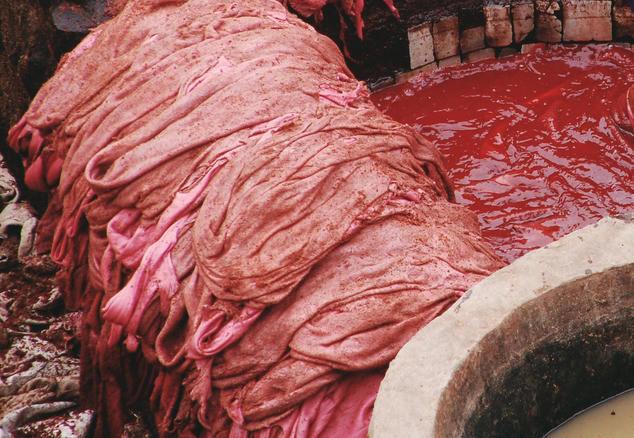The environmental footprint of fashion is out of control. According to the National Resources Defense Council (NRDC), “Textile mills generate one-fifth of the world's industrial water pollution and use 20,000 chemicals, many of them carcinogenic, to make clothes.”

Fabric being dyed in factory. Image from NRDC.org.
A Problem That Impacts Everyone
Did you know it takes about 200 tons of water (enough to fill several swimming pools) to produce one ton of cotton fabric? That water is filled with dyes and carcinogenic chemicals to scour, dye, rinse, and finish garments, then dumped into water supplies without treatment. Textile mills also require a considerable amount of energy to power manufacturing, and the resulting pollution is pumped into our air.
Here are three ways brands, manufacturers, and consumers can promote and support change.
1. Clean by Design
Experts at the Natural Resources Defense Council (NRDC) have been studying textile mills to identify ways they can reduce their environmental impacts. From their research came Clean by Design (CBD), a green supply chain efficiency program designed to help apparel retailers and fashion brands reduce water, chemical, and energy usage in their factories abroad.
Big brands are stepping up, and the benefits are huge. Target, Gap, and H&M have all implemented CBD to improve the environmental practices of their overseas textile mills with excellent results. According to NRDC, “Each mill in the 2014 program reduced water use by up to 36 percent and cut energy use by as much as 22 percent while also cutting 400 tons of chemicals from their processes. An added bonus? Each mill saved an average of nearly $500,000.”
Gap, for example, has already saved 2.4 billion liters of water through sustainable manufacturing practices, and has set a goal to conserve 10 billion liters by the end of 2020. This is enough daily drinking water for 5 billion people.

Dying batik fabric in Phrae, Thailand. Image from NRDC.org.
2. Sustainable Fabrics
More and more consumers are choosing sustainable fabrics, and many brands are answering the call for environmental responsibility.
Lenzing, an Austrian manufacturer, creates a collection of fabrics made from wood pulp and recycled cotton scraps. The wood pulp used in REFIBRATM lyocell (TENCEL®) is a renewable raw material from sustainably managed forests. The solvents used to process the wood and cotton fibers are 99.7% captured and can be used over and over again, reducing water usage 95% compared to cotton fabric manufacturing with zero air, soil, or water pollution.
Lenzing recently showcased at Heimtextil, and brands like Patagonia are using it to create sustainable clothing lines.

Patagonia partners with the TAL group to sweep the floors of their factories in China and Malaysia, saving hundreds of tons of cotton to be spun into functional fabric.
3. Color Management
Effective color management is crucial for reducing environmental impact in textile production. Tools like PANTORA and Textile Color Hub enable brands and manufacturers to implement sustainable color practices and minimize physical sample production and shipping.
Visual assessment tools like color references and controlled lighting help set realistic expectations and minimize subjectivity. Formulation software enables more accurate initial color matches and minimizes corrections. It can also create recipes that include recycled raw materials and leftover materials from previous dye formulations to minimize waste.
Color measurement devices and quality control software identify color drifts so they can be corrected before they ruin the production run.
Promoting Sustainable Practices with X-Rite Pantone Textile Color Hub
Effective color management is vital for reducing the environmental impact of textile production. Traditional color approval workflows involve shipping physical samples, which wastes materials and slows time to market. Textile Color Hub, a smart color solution, allows brands and suppliers to evaluate and approve lab dips digitally to reduce the waste and carbon footprint of physical samples. This platform empowers dye houses to achieve up to 95% accuracy in lab dips on the first try, improving time to market by 75%.
Textile Color Hub supports spectrophotometers from X-Rite and other manufacturers and connects with NetProfiler for high-quality color calibration. This integration optimizes and validates supplier spectrophotometers, ensuring consistent color quality and promoting sustainability in the textile supply chain.
Driving Positive Change in Textile Sustainability
Whether you're a brand, manufacturer, or consumer, embracing sustainable practices in textile production is crucial. Even small improvements in color management and material sourcing can contribute to significant reductions in environmental footprint.
- Download this free whitepaper to learn how textile manufacturers and supply chains can optimize a traditional color workflow.
- Read this application brief to learn how colorists can cut production time in half.
- Get in touch to learn more about how X-Rite can help.
